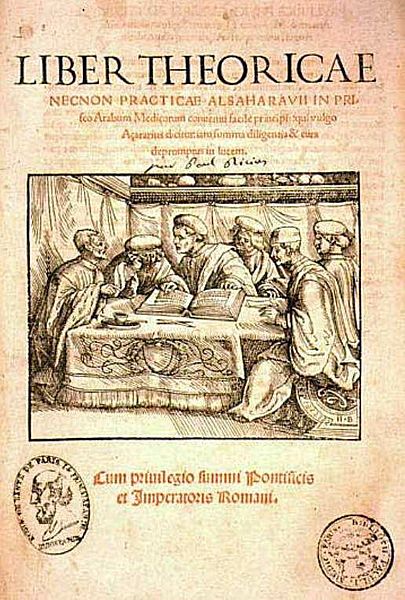Image: Al-zahrawi great surgeon 03

Description: This book is a compendium of medical works, printed in Basel in 1541 by the shop of Heinrich Petri (1508–79), also known by his Latinized name Henricus Petrus. It includes the Latin translation of the 30th chapter of the celebrated al-Taṣrīf li man ‘ajiza al-ta’līf (The arrangement of [medical knowledge] for one who is unable to compile [a manual for himself]) by the important Andalusian physician Abū al-Qāsim ibn al-‘Abbās al-Zahrawī. The book also contains a four-part work concerning the treatment of wounds and lesions by Rolandus Parmensis (flourished early 13th century); a work on surgery by Rolandus’s teacher, the celebrated Ruggero Frugardo (circa 1140–95); three short works by Constantinus Africanus (circa 1020-87), De humana natura, De elephantia, and De animalibus; and De purgationibus by the Paduan physician Antonius Gazius (1449–1528). Not much is known about the life of al-Zahrawī, whose name indicates that he was born in Madinat al-Zahrā, near Cordoba. According to the earliest sources he died in al-Andalus after 1009. Later biographers state that al-Zahrawī worked at the Andalusian courts of ʻAbd al-Raḥmān III, Caliph of Cordoba (reigned 912–61); Ḥakam II, Caliph of Spain (reigned 961–76); or Manṣūr ibn Abī ʻĀmir, de facto ruler of al-Andalus 978–1002. Al-Zahrawī’s only surviving work is the enormous al-Taṣrīf, written in 30 chapters. Chapters one (on general principles), two (on the symptoms and treatments of diseases), and 30 (on surgery) form almost half the work. Al-Zahrawī relied on earlier sources (Paulus of Aegina, Ibn Māsawayh, Sābūr ibn Sahl, Isḥāq ibn ‘Imrān, Qustā ibn Lūqā, al-Rāzī, Ibn al-Jazzār, and others), but he also drew upon his own experience as a practicing physician. Al-Taṣrīf enjoyed considerable fame in the Islamic world and in Europe. The first and second chapters were translated in the mid-13th century into Hebrew and subsequently into Latin, and appeared in Augsburg in 1519 under the title of Liber theoricae nec non practicae Alsaharavii. The 28th chapter, on “the improvement of medicines, the burning of mineral stones and the medical uses thereof,” was translated into Hebrew and thence into Latin at the end of the 13th century under the title Liber Servitoris and first printed in 1471 by Nicolas Jenson. The chapter on surgery contained in this text was the first comprehensive and illustrated treatment of its subject. The author’s expressed purpose was to revive the art of surgery as taught by the “ancients,” the surgeons of the Hellenistic tradition. This chapter was translated into Latin at Toledo by Gerard of Cremona under the title of Liber Alsaharavi de cirurgia. It was first printed in Venice in 1497; later editions followed in 1499, 1500, 1520, 1532, and 1540. Blood--Circulation; Diseases; Elephantiasis; Human anatomy; Medicine, Arab; Medicine, Medieval; Nutrition; Pharmacology; Surgery
Title: Al-zahrawi great surgeon 03
Credit: https://www.wdl.org/en/item/9552/
Author: This image is of a compendium of medical works, printed in Basel in 1541 by the shop of Heinrich Petri (1508–79), also known by his Latinized name Henricus Petrus.
Usage Terms: Public domain
License: Public domain
Attribution Required?: No
Image usage
The following 2 pages link to this image:

